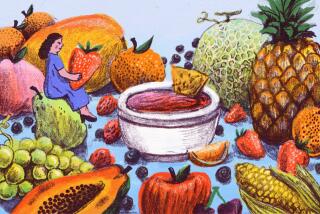Zeal for New Tastes May Spell Success for Carambola, Mamey Sapote, Atemoyas : S. Florida Growers Banking on ‘Yuppie Fruits’
- Share via
HOMESTEAD, Fla. — Fruit growers in South Florida are gambling that a yuppie demand for something new and different to eat will establish a market for some exotic tropical fruits with funny names.
From this farm belt near Miami, they have begun shipping out such rare crops as star fruit (carambola), mamey sapote, atemoyas, sugar apples, monastera and low-calorie longans and lychees.
“They’re yuppie fruits,” says Marc Ellenby, owner of the Comfort Grove.
“We are gambling that a good deal of these are going to hit and become staple items,” says Bill Schaefer, marketing director for J.R. Brooks & Son Inc., a Homestead fruit and vegetable shipper “And I think they will.
“We are responding to the 1980s call of ‘What do you have that’s new and different?’ ”
Schaefer says that in 1983 his company shipped only mangoes, limes and avocados. Last year, the rare tropical fruits made up about 5% of Brooks’ $35 million in gross sales.
‘Exciting Time’
“It’s a very exciting time for tropical fruit growers in South Florida,” says Ellenby.
Growers concede that there are problems. Some fruits have short shelf lives or don’t ship well. Also, with supply lagging behind demand, one piece of fruit may cost several dollars.
No Bananas, Peggy Kenney’s fledgling Miami fruit distribution firm, in fact sells no bananas. She ships rare fruits to restaurants and grocers in New York, Texas and Colorado.
“The demand is good,” she says. “It’s the gourmets. But many shoppers are hesitant to buy because of the high prices.”
About 10 years ago, California’s kiwis languished on shelves. Then the price came down, and now kiwis are selling like hot cakes, says Max Nisson, co-owner of Fresh World, an Atlanta specialty foods distributor who does a lot of business with South Florida growers.
Schaefer thinks the tastes of the times are changing and that kiwi-like popularity is just around the corner for the new South Florida crops, especially the pretty carambola, which comes in sweet and tart varieties.
The specialty food market started about a dozen years ago. Growers wanted new crops, grocers wanted new produce and consumers wanted a change.
Why?
“Boredom with the run-of-the-mill,” says Murray Corman, president of the Rare Fruit Council International Inc., a Miami-based study group. “Increased disposable income for the yuppies. And better marketing.
“Compare these with fruits popularized in recent history,” he adds. “Kiwi, a mediocre fruit, or cranberry, basically a terrible fruit.”
Good Business Sense
Dade County growers say their business sense tells them to plant rare fruits and keep pace with the trend, according to agriculture agent Mary Lamberts.
Vegetables brought in $180 million in 1984-85, the last year for which statistics are available from the U.S. Department of Agriculture. Growers earned $44.39 million from their 22,230 acres of fruit that year.
Avocados brought in $12.5 million, limes $19.9 million, mangoes--a peach-like fruit--$5.6 million. Other top sellers were papayas, bananas, lychees, carambola and mamey sapote, the latter a custardy fruit that comes in two flavors.
Carambolas, which when sliced fall into five-pointed stars, were listed separately for the first time in new statistics because their production had increased.
“They’ve caught on,” Lamberts says. “Carambolas are sexy. You open them up and they’re pretty.”
Growers are excited.
“Business is wonderful,” says Joan Green, the owner of Green’s Gourmet Grove. “People are anxious to try new food.”
She said her 5-year-old business this year should ship out some 70,000 pounds of carambola, plus longans, a lychee relative, and atemoyas, a pudding-sweet pulpy hybrid of sugar apples favored by Latins.
“We think there’s a great future for this fruit,” she says.
Nisson, of Fresh World, which markets specialty foods to restaurants and groceries in 14 Southeastern states, agrees that rare fruit sales have surged. But his enthusiasm doesn’t match that of the growers.
“Carambola is wonderful,” he says, “but it’s not for everybody. Growers don’t understand what’s happening at the other end of the delivery truck.”
Corman disagrees.
“With proper marketing,” he says, “it’s going to be a boon for South Florida.”
Schaefer thinks proper marketing and advertising will create a niche for rare tropical fruits. And crops planted this year mean lower prices in a few seasons.
“The market for tropicals is everywhere,” he says. “Consumers will buy without having the first bit of information about what it is.”
He remembers a Pittsburgh woman who called to ask him what to do with the carambola she had just bought. Her call led to Brooks sponsoring a carambola recipe contest.
“We tested them and had horrible results,” he says.
Brooks’ chefs slowly realized that some recipes were for tart and others for sweet star fruits, but that people who didn’t know the difference hadn’t specified which to use in their recipes.
Brooks now includes fruit information and recipes with each box they ship.
More to Read
Sign up for The Wild
We’ll help you find the best places to hike, bike and run, as well as the perfect silent spots for meditation and yoga.
You may occasionally receive promotional content from the Los Angeles Times.






